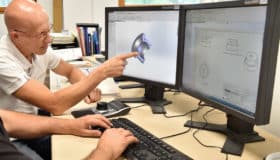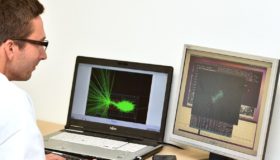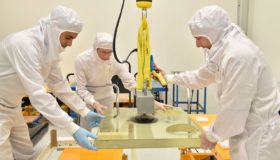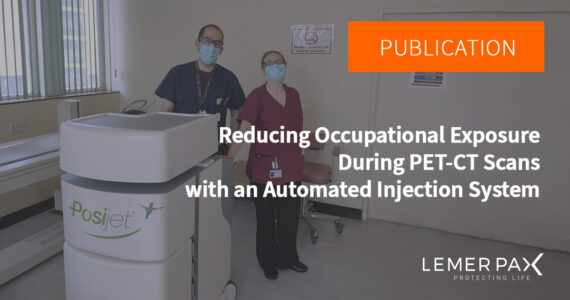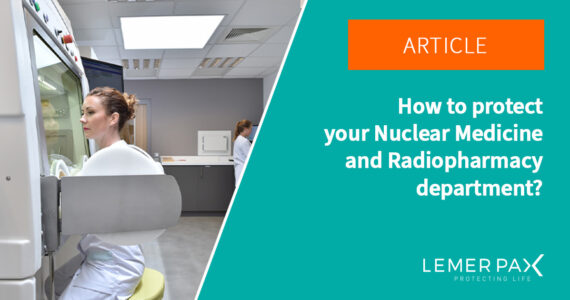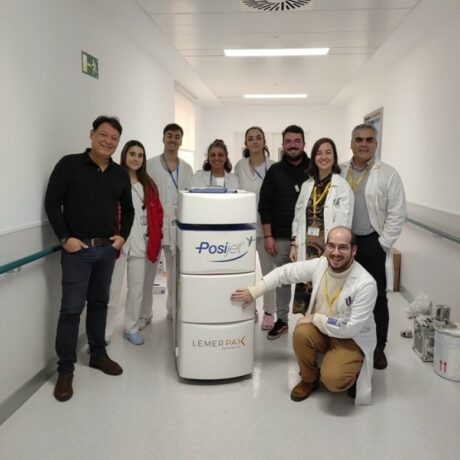
Reduction of staff exposure to ionizing radiation in PET imaging centres through the use of automatic and semi-automatic injection equipment
C. Villar[1], C. Andrés¹, S. Pena¹, P. Montoya¹, D. Viñé¹, A. Viloria¹, N. Álvarez[2], R. Ruano², R. Torres¹
Forty-first edition of the SEMNIM Congress (Spanish Society of Nuclear Medicine and Molecular Imaging) – Valladolid, 21–23 May 2025
The purpose of this study is to evaluate the difference in personal equivalent doses Hₚ(0.07) (assessment of dose to the skin, hands, and feet) and Hₚ(10) (assessment of effective dose) for workers exposed in PET imaging when using automatic and semi-automatic injection equipment, compared with the manual preparation and administration of ¹⁸F.
MATERIALS AND METHODS:
The study was conducted on 253 patients, including 170 with an automatic injector and 83 with a semi-automatic system. Active Hₚ(10) dosimeters and extremity (ring) Hₚ(0.07) dosimeters were used for both injection systems, with readings normalised according to the activity administered. These readings were compared with values from the literature for the manual technique.
The Posijet® automatic system is a stand-alone piece of equipment designed to calibrate and inject ¹⁸F. The radiographer inserts the ¹⁸F vial into the piece of equipment and prepares the activity to be injected, while the nurse is responsible for the administration.
The semi-automatic system consists of two components: a dose preparation system located inside a handling hot spot shielded with 50 mm lead, combined with a dual-channel syringe pump (shielded with 6 mm lead glass).
RESULTS:
The normalised values obtained with both types of equipment, as well as those from the manual method, are presented in the table below:
| POSIJET® | SEMI-AUTOMATIC SYSTEM | MANUAL SYSTEM | ||||
| Hp (10)/A [µSv/MBq] | Hp (0.07)/A [µSv/MBq] | Hp (10)/A [µSv/MBq] | Hp (0.07)/A [µSv/MBq] | Hp (10)/A [µSv/MBq] | Hp (0.07)/A [µSv/MBq] | |
| Nursing assistant | 0.0031 | 0.0166 | 0.0044 | 0.1429 | 0.0056 | 0.9297 |
| MERM | 0.0020 | 0.0335 | 0.0025 | 0.2631 | 0.0029 | 1.200 |
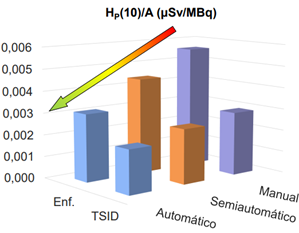
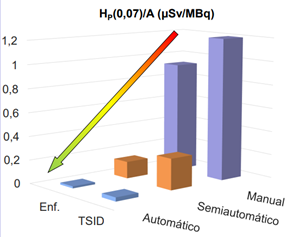
The readings obtained with both devices are presented in Table 1, along with the values obtained using the manual technique.
Compared with the manual technique, the automatic system reduced Hₚ(10)/A by 44.4% for nursing staff and by 31.2% for radiographers, while Hₚ(0.07)/A was reduced by 98.2% and 97.2%, respectively.
Avec le système semi-automatique, Hₚ(10)/A diminue de 21,3% pour le personnel infirmier et de 15,6% pour les manipulateurs en électroradiologie médicale, tandis que Hₚ(0,07)/A diminue respectivement de 84,6% pour le personnel infirmier et de 78,1 % pour les manipulateurs en électroradiologie médicale.
CONCLUSIONS:
The use of automatic or semi-automatic injection equipment significantly reduces the radiation doses received by exposed professionals. Fully automated systems reduce extremity doses by more than 95% and the effective dose by around 50%, thereby substantially enhancing radiation protection in PET departments.
By limiting radiation exposure, these systems reduce the risk of long-term adverse effects and provide effective protection for the various professional groups involved at different stages of the diagnostic process.
Click here for the digital version of the poster (in Spanish)
[1] Department of Radiophysics and Radiation Protection, University Clinical Hospital of Valladolid, Spain
[2] Department of Nuclear Medicine, University Clinical Hospital of Valladolid, Spain
